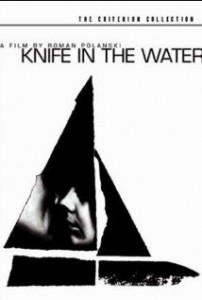Knife in the Water
Directed by Roman Polanski
Poland, 1962
Certainly a stretch to categorize as horror, Roman Polanski’s debut feature anticipates the creeping dread and tense blocking that will characterize his later, truer films of the genre.
Husband and wife Andrzej (Leon Niemczyk) and Krystyna (Jolanta Umecka) pick up a young hitchhiker (Zygmunt Malanowicz) on their way to a sailing outing. The young man joins them on the water and tensions rise among the three as the men jockey for power.
Coming after a number of murky, eerie shorts – including 1957’s grim A Murder – Knife in Water is Lifeboat meets Dead Calm but with Polanski’s signature brooding unease rather than overt, textbook suspense or violence. Repulsion, Rosemary’s Baby, and The Tenant make up the director’s “Apartment Trilogy,” and though Knife in Water is almost exclusively on open water it may as well mark the beginning of a “Claustrophobia Quadrilogy.” The film touts Polanski’s ability to shoot in deep focus and emphasize taut relationships through blocking, something he perhaps owes to Orson Welles, who released a film that could be a close visual cousin to Knife in the Water also in 1962: The Trial.

Visual cues give a foreboding indication of the intruder storyline to come – a narrative trope that Polanski will again explore in his third film, 1966’s Cul-de-sac. The opening shot, a medium 2-shot through the windshield of a moving car, shows husband and wife in ominous shadows. The reflections of the overhead trees pass by the unnervingly faceless driver and passenger until cinematographer Jerzy Lipman’s lighting finally reveals their stoic faces.
Once the nameless young hitchhiker is present on the boat, Polanski finds multiple opportunities to switch he and the Andrzej between extreme foreground and background, often divided by the sail or by Krystyna, both representations of masculinity: control of the ship and sexual control.


The horror in Knife in the Water is on one-hand derived from the potential for violence. Once the eponymous knife – a rather large and phallic one at that – is brought into visual play its presence looms large over the film. Beyond that are various expository clues (the young man can’t swim), sound design elements (a radio boxing match that becomes synonymous with the hostility between the hitchhiker and Andrzej), and literal physical aggression that points the audience towards some inevitable grim denouement.

Knife in the Water is a horror film in the same way that Straw Dogs is, though it’s decidedly less brutal than Sam Peckinpah’s film. It’s rather cat-and-mouse-like, playing with expectations and anticipation rather than any gruesome display.


